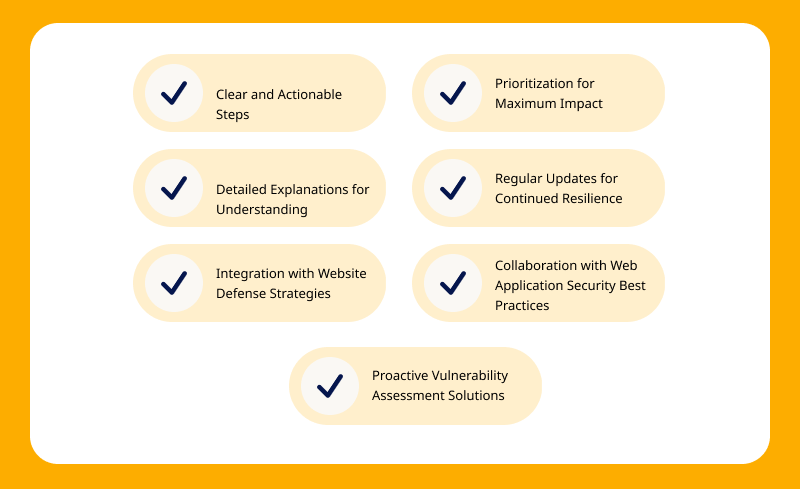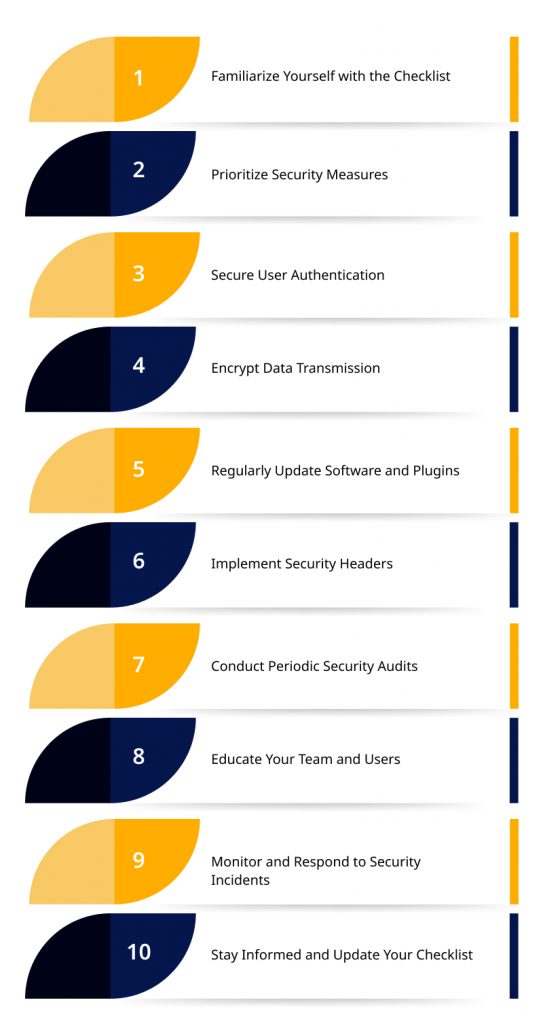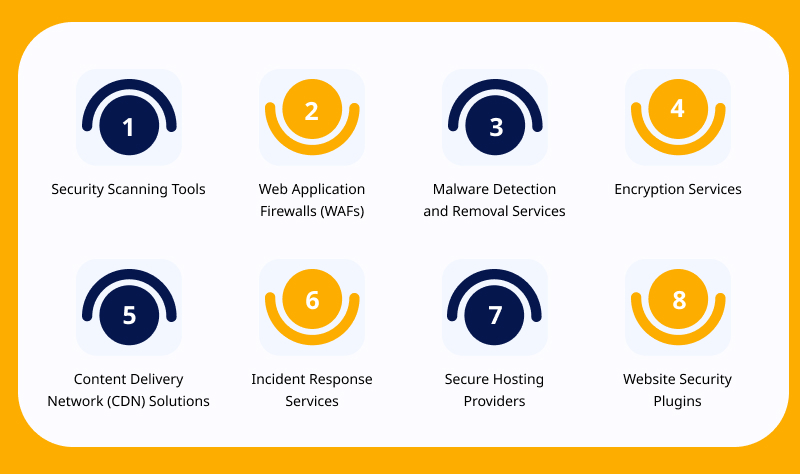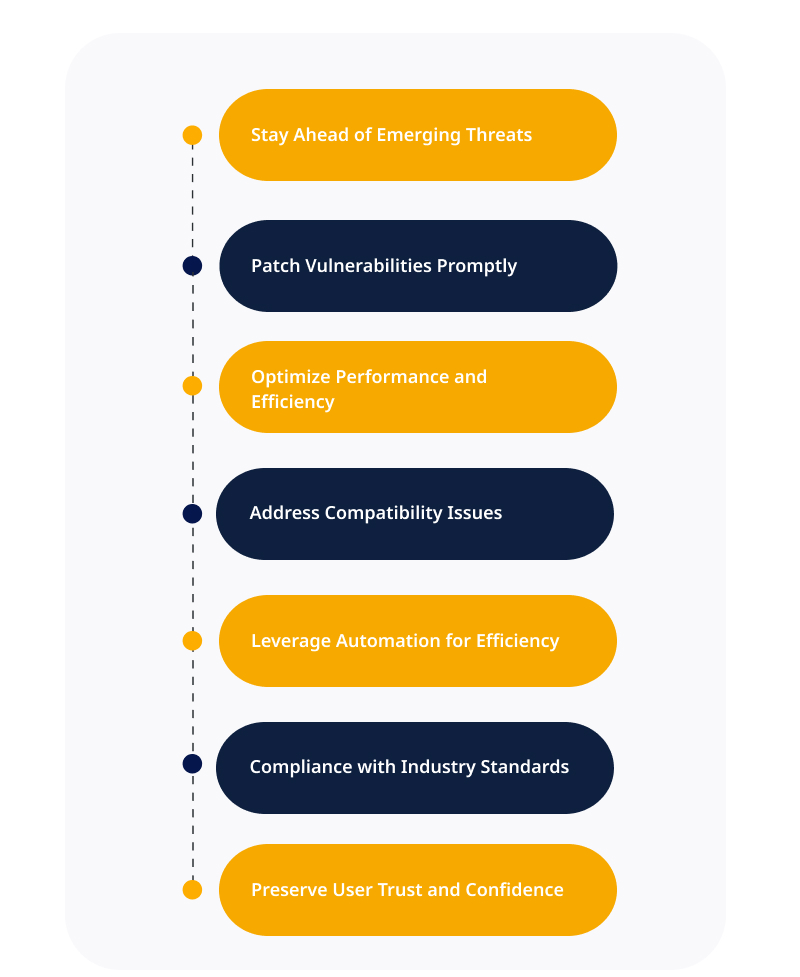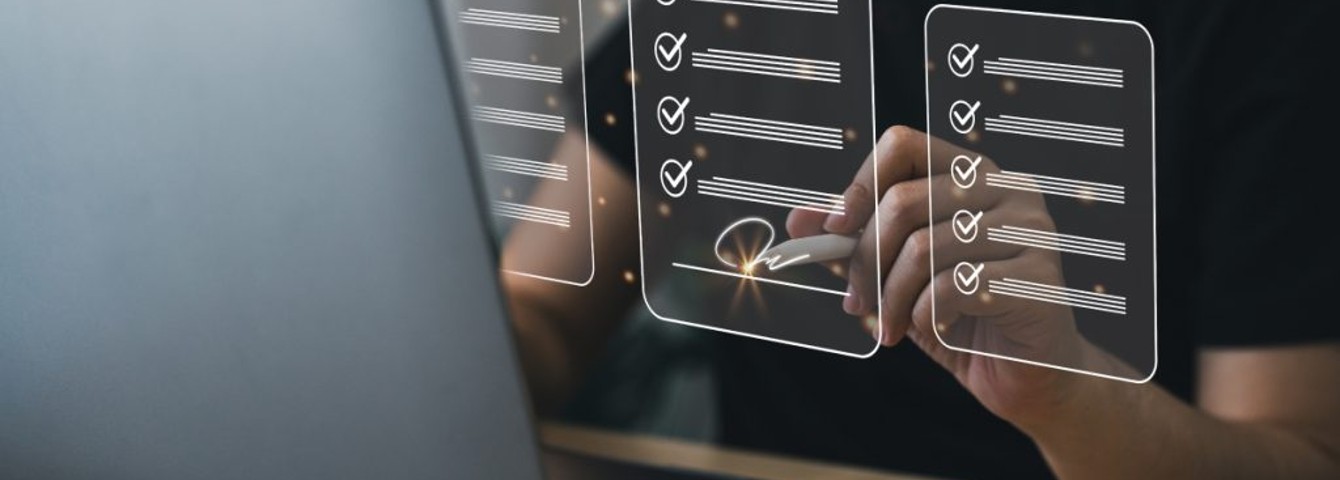Quick Overview
This blog offers a practical guide to fortifying your website as cyber threats rise. Walking through an evaluated security checklist, we provide clear explanations and actionable steps to implement critical safeguards. Learn how to protect user data, build trust, and maintain robust defenses with measures like encryption and vulnerability testing for your website.
When was the last time you conducted a security audit for your website?
With over 94 web attacks occurring each day, the threats are increasing exponentially. Yet studies show that small business websites operate without adequate safeguards.
What would happen if your site was compromised?
Could you afford leaked customer data, legal liabilities, or loss of revenue? The consequences underscore the importance of proactive website security.
A secure website builds customer trust and demonstrates your commitment to risk management. This comprehensive website security checklist guides you through implementing critical protections on your website.
Follow our practical, step-by-step recommendations to encrypt sensitive information, restrict access, test for vulnerabilities, and more.
Our checklist helps you prioritize the most urgent security gaps. With vigilance, updating protocols, and occasional outside audits, you can protect your online presence for the long haul. Let’s get started!
The Growing Importance of Website Security
The risks associated with an insecure website are rising. The global cybercrime costs are predicted to reach $10.5 trillion by 2025, emphasizing the need for enhanced cybersecurity measures. Hackers are deploying more advanced methods to exploit vulnerabilities and access sensitive data.
ValueCoders specializes in implementing robust security measures to safeguard your brand.
The potential consequences underscore the urgency of prioritizing website security checklist measures. Breaches expose businesses to substantial financial damages, compliance penalties, and reputation loss.
A 2024 survey found that consumers would avoid companies that suffered a cyberattack. Moreover, inadequate safeguards make websites vulnerable to outages and blackmail. With more daily operations moving online, the downtime impacts are intensifying.
Proactively securing your website fortifies it against evolving threats like worms, viruses, zero-day exploits, and injection attacks. Security testing services also assess new vulnerabilities that may emerge in coding gaps or outdated software.
Companies can assure customers, protect critical assets, and demonstrate effective risk management by implementing rigorous defenses and continuing vigilance. The following checklist outlines critical steps for locking down your website.
Understanding the Threat Landscape
To secure your website, you must understand the constantly evolving threat landscape. Hackers and cybercriminals deploy more advanced persistent threats to acquire data or disrupt operations. Common threats include:
- Malware attacks: Attacks involving malicious software that infects systems, steals data, encrypts files for a ransom, or disrupts services.
- Phishing scams: Emails or websites masquerading as reliable entities that trick users into revealing confidential information.
- SQL injection: Harmful code insertion into a web application database for accessing, corrupting, or deleting sensitive data.
- Zero-day exploits: Attacks that leverage software vulnerabilities unknown to software developers.
Effective web security checklist 2024 measures such as patching, encryption, user access controls, and online threat prevention tips can protect websites from breaches.
Continued security in software development and vigilance are vital to mitigating emerging threats. Implementing robust defenses reduces high-impact cyber incidents.
Also read: Top Software Security Tips & Best Practices
The Importance of Website Security
In the interconnected digital landscape, prioritizing website security is not just good practice; it’s essential for the integrity of your online presence. Let’s understand why securing your website is paramount:
1. Safeguarding Sensitive Data: In a world where data is the new currency, a breach can have far-reaching consequences. Using a robust website security checklist helps to protect sensitive user information.
2. Preserving User Trust: Trust is the cornerstone of online interactions. A secure website reassures users that their data is handled responsibly. Implementing website security best practices contributes to a positive user experience and fosters long-term trust.
Implement our site security checklist for a robust defense that ensures your brand's digital resilience.
3. Mitigating Financial Risks: A security breach costs more than monetary. Beyond financial losses, a compromised website can lead to legal implications. Adhering to a comprehensive website security checklist helps mitigate these risks and safeguards your business continuity.
4. Reputation Management: Your online reputation is fragile. A security breach can tarnish your brand image and erode customer confidence. Upholding website security best practices is a proactive strategy for preserving your reputation in the digital landscape.
5. Regulatory Compliance: The regulatory landscape is evolving. Aligning your website with the latest security standards, guided by a current website security checklist, ensures compliance with data protection regulations and shields you from legal consequences.
6. Defending Against Cyber Threats: The digital realm is fraught with threats. From malware to sophisticated cyber-attacks, your website is a potential target. A vigilant adherence to website security best practices fortifies your defenses, making it harder for malicious actors to succeed.
7. Supporting Cybersecurity in Software Development: Security should be ingrained in every line of code. Integrating cybersecurity in software development practices ensures that security measures are an integral part of the development process, enhancing overall resilience.
The importance of website security extends far beyond technological considerations. It is a strategic imperative for businesses thriving in the digital age.
Adopting and regularly updating a robust website security checklist will fortify your online presence and contribute to a safer digital environment for all.
ValueCoders’ Site Security Checklist
Discover the power of protection with ValueCoders’ Site Security Checklist, a comprehensive guide designed to fortify your digital fortress. Here’s how our meticulous approach ensures the security of your online assets.
1. Clear and Actionable Steps: In security, clarity is vital. Our website security checklist provides straightforward, step-by-step instructions, making it accessible for both tech-savvy individuals and those new to the security landscape.
2. Prioritization for Maximum Impact: Not all security measures are created equal. ValueCoders’ checklist employs a strategic approach, prioritizing actions to address the most critical vulnerabilities first. This ensures a focused and impactful defense strategy.
3. Detailed Explanations for Understanding: Understanding the “why” is as crucial as the “how.” Each security measure in our website security checklist comes with detailed explanations, empowering you to comprehend the significance of each step in safeguarding your digital assets.
4. Regular Updates for Continued Resilience: The security landscape evolves, and so do we. ValueCoders is committed to regularly updating the website security checklist, aligning it with the latest threats and industry best practices to keep your defense mechanisms sharp.
5. Integration with Website Defense Strategies: Our checklist is not just a list; it’s a strategic defense plan. We seamlessly integrate our website security checklist with proven website defense strategies to create a comprehensive shield against many potential threats.
6. Collaboration with Web Application Security Best Practices: In the ever-evolving world of web applications, staying ahead is imperative. ValueCoders’ checklist aligns with current web application security best practices, ensuring that your defenses align with the latest industry standards.
7. Proactive Vulnerability Assessment Solutions: Identify weaknesses before they become threats. Our checklist incorporates proactive vulnerability assessment solutions to pinpoint potential vulnerabilities, allowing you to patch them before malicious actors exploit them.
ValueCoders’ site security checklist goes beyond a mere checklist; it is your digital guardian.
Following our guidance, you can secure your online assets and better understand the dynamic digital security world. Elevate your defense strategy with ValueCoders.
Read more: Implementing Security in PHP Web Apps
Step-by-Step Implementation Guide
Going on the journey of securing your digital stronghold? Let’s review the process with our website security checklist and ensure a robust defense. Here’s your step-by-step implementation guide:
1. Familiarize Yourself with the Checklist
Start by acquainting yourself with our comprehensive website security checklist. Understand the purpose of each security measure to make informed decisions during implementation.
2. Prioritize Security Measures
Before diving in, prioritize the security measures based on your website’s unique needs. Our website security checklist provides a clear roadmap, guiding you to address the most critical aspects first.
Prioritize security to ensure excellence in implementing and maintaining security measures.
3. Secure User Authentication
Begin with the gateway to your digital realm. Secure website development tips often highlight the importance of robust user authentication. Implement multi-factor authentication to fortify access control.
4. Encrypt Data Transmission
Secure the highways of data transfer. Enable encryption protocols like HTTPS to safeguard sensitive information during transit. This ensures data remains confidential and protected from interception.
5. Regularly Update Software and Plugins
Stay on top of the latest defenses. Regularly update your software and plugins as per the recommendations in our website security checklist. Outdated components can be potential entry points for cyber threats.
6. Implement Security Headers
An often overlooked yet effective defense layer. Incorporate security headers as suggested in our checklist. These headers add an extra shield, enhancing the overall security posture of your website.
7. Conduct Periodic Security Audits
Be proactive in identifying vulnerabilities. Periodically conduct security audits using tools or software QA & testing services. This ensures continuous assessment and swift resolution of potential security gaps.
8. Educate Your Team and Users
Turn your team and users into allies. Share and secure website development tips with your team and users. Educated individuals contribute to a collective security awareness, strengthening the overall defense.
9. Monitor and Respond to Security Incidents
Stay vigilant and responsive. Monitor your website for unusual activities and have an incident response plan in place. A swift response can minimize the impact of a potential security incident.
10. Stay Informed and Update Your Checklist
The security landscape is dynamic. Regularly update your website security checklist to align with emerging threats and industry best practices. Stay informed and evolve your defense strategy accordingly.
Therefore, this step-by-step implementation guide and our website security checklist are your blueprints for digital fortification. By following these steps diligently, you secure your website and cultivate a culture of continuous improvement in your digital defense strategy.
Read more: Why Software Testing Is Crucial For Your Business
Tools and Services
Improve your defense arsenal with a curated selection of tools and services designed to complement our website security checklist. These resources empower you to fortify your digital fortress and secure your online presence effectively.
1. Security Scanning Tools
Ensure your website’s vulnerabilities are thoroughly examined. Security scanning tools like Nessus and Qualys provide in-depth assessments, aligning with the principles outlined in our website security checklist.
2. Web Application Firewalls (WAFs)
Provide an additional layer of protection for your online assets. WAFs like Cloudflare and ModSecurity are instrumental in preventing common web application attacks and securing your website beyond the measures in the website security checklist.
3. Malware Detection and Removal Services
Stay vigilant against hidden threats. Engage services such as Sucuri or Wordfence for continuous monitoring and rapid malware removal, complementing your efforts to secure your online presence.
4. Encryption Services
Protect sensitive data with advanced encryption. Leverage tools like Let’s Encrypt to implement and manage SSL/TLS certificates quickly. Encryption is fundamental to securing online communication, as our website security checklist highlights.
5. Content Delivery Network (CDN) Solutions
Optimize performance while enhancing security. CDNs like Akamai or Cloudflare accelerate content delivery and protect against DDoS attacks, reinforcing your tips for a secure WordPress website.
6. Incident Response Services
Prepare for the unforeseen with expert guidance. Engage services like Mandiant or CrowdStrike to have a robust incident response plan in place. Quick and effective responses are crucial components of a comprehensive website security checklist.
7. Secure Hosting Providers
Begin with a secure foundation. Choose hosting providers renowned for their commitment to security, such as SiteGround or WP Engine. A secure hosting environment aligns with the principles of securing your online presence.
8. Website Security Plugins
Tailor security measures to your content management system. Leverage plugins such as Sucuri Security or Wordfence Security specifically tailored for WordPress platforms. These plugins serve as valuable additions, harmonizing seamlessly with the security recommendations outlined in our checklist for a fortified and secure WordPress website.
These tools and services serve as invaluable additions to your website security checklist. Incorporate them strategically to reinforce your digital defenses, ensuring a resilient and secure online presence. Stay proactive, stay secure.
Also read: Security Tips For Your WordPress Site
Regular Updates and Maintenance
Ensuring the security of your website is not a one-time task but an ongoing commitment. Regular updates and maintenance are the pillars of a secure digital presence. Let’s delve into why this continuous effort is crucial.
1. Stay Ahead of Emerging Threats
In the ever-evolving cyber threats landscape, staying ahead is paramount. Regularly updating your website security checklist aligns your defense mechanisms with the latest trends and vulnerabilities, ensuring you’re prepared for emerging threats.
2. Patch Vulnerabilities Promptly
Vulnerabilities can arise unexpectedly. Regular maintenance allows you to patch any vulnerabilities identified promptly through your website security checklist. Timely action prevents potential exploits and strengthens your website’s resilience.
3. Optimize Performance and Efficiency
Beyond security, regular updates contribute to overall performance. Software updates often include enhancements that optimize your website’s efficiency. This dual benefit ensures your website stays secure and functions at its best.
4. Address Compatibility Issues
Technology evolves, and so should your website. Regular updates help address compatibility issues, ensuring your website remains functional across various devices and platforms. This adaptability is vital for a seamless user experience.
5. Leverage Automation for Efficiency
Automation streamlines the update process. Utilize tools and services, such as an app to monitor traffic & security, to automate routine tasks. This ensures efficiency and reduces the risk of human error during the maintenance process.
ValueCoders guarantees the security your brand needs to thrive and succeed in the digital realm.
6. Compliance with Industry Standards
Stay in line with industry standards and regulations. Regular updates are crucial for compliance with evolving standards. This is particularly important for sectors where adherence to regulations is mandatory.
7. Preserve User Trust and Confidence
Users value a secure and reliable experience. You are committed to their security and build trust by consistently updating and maintaining your website. Trustworthy websites garner confidence and loyalty from users.
Regular updates and maintenance are not merely tasks; they are a continuous commitment to the security and functionality of your website.
Adopt this proactive approach to fortify your digital presence and provide a resilient and reliable online experience. Stay updated, stay secure.
Also read: Cybersecurity In Software Development
Final Words
Securing your online presence against intensifying threats is a continuous process. With this comprehensive website security checklist, you now have the blueprint to lock down your website.
- Audit our step-by-step recommendations and implement the most urgent safeguards first.
- Subscribe to regular security notices so you can patch emerging vulnerabilities quickly.
- Consider engaging ValueCoders for expert penetration testing, infrastructure hardening, and building secure code.
You can stay two steps ahead with ongoing maintenance, adaptations to new attack vectors, and occasional outside audits. A trusted, airtight website demonstrates your commitment to customers and sets you apart from reactionary competitors.
Ready to get started? Contact ValueCoders today to begin the process of strengthening your website defenses. Our cybersecurity consultants help future-proof your site so you can focus on fueling innovation and driving growth.





